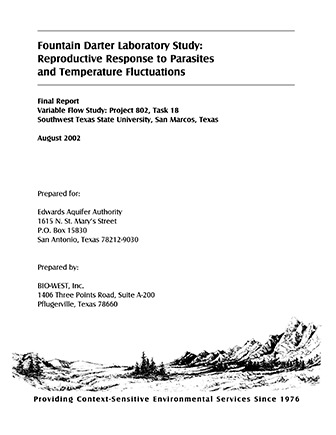Fountain Darter Laboratory Study Repoductive Response to Parasites and Temperature Flucuations

| Author | Bonner TH and McDonald D |
| Year | 2002 |
| Description | Laboratory study of effects of temperature fluctuations and parasites on reproduction in the fountain darter |
| Report Number | Southwest Texas State University Variable Flow Study: Project 802, Task 18 |
| Publisher | Bio-WEST, Inc |
| Location | Comal River, San Marcos River [Laboratory] |
| Cover | View Download |
| File | View Download |
| Summary |
|
[from the Executive Summary] …The following study was conducted by Dr. Timothy Bonner (Southwest Texas State University) to examine … with a controlled laboratory experiment… the effect of fluctuating temperatures and cercariae (parasite) infestation on total egg, healthy egg, and larval production. Temperatures included a constant 24°C, fluctuating 24 to 26°C, fluctuating 26 to 28°C, and fluctuating 28 to 30°C; all fluctuations were on a 12h day, 12h night cycle. These temperatures were chosen because the lowest level falls within the range of temperatures commonly found in fountain darter habitats. The next two treatments had temperatures that may potentially be reached during low-flow/high temperature periods (~26°C); the last treatment included a range above the “worst-case scenario” to evaluate the potential improvement with the 2°C diel fluctuation. Dr. Bonner’s report detailing his methods and results is attached. The first analysis revealed that parasites did not have an effect on egg or larval production, so darters with and without parasites were lumped for all other analyses. This is an important finding of the study. Parasites are a concern in the Comal Springs ecosystem because of high rates of infestation, particularly in areas where the fountain darters are most abundant (old channel). Parasites do not appear to cause mortality directly in the wild (T. Brandt, USFWS, personal communication) but have been assumed to have sub-lethal effects (cause greater stress, reduce predator avoidance, reduce reproductive ability). These results suggest that, at least in the early stages of infestation, there is little effect on reproductive capability. It is possible; however, that long-term infestation or greater parasite loads may have negative effects that were not observed here. There were significant differences observed between temperature treatments in the number of healthy eggs and larvae produced; the 24°C treatment resulted in significantly more eggs overall, healthy eggs and larvae than any other trial. This is not surprising since this temperature is within the range of mean temperatures found in areas where fountain darters are abundant. The two treatments with increasingly higher temperatures (24-26°C and 26-28°C) had similar numbers (not significantly different) of total eggs and healthy eggs produced, but the number of larvae produced was lower in the 26-28°C treatment. The 28-30°C treatment resulted in virtually zero eggs produced. Although standardizing healthy eggs and larvae produced by percentage of total eggs produced did reveal less significant differences between treatments, the large decline in total egg production between treatments suggests that temperatures in the ranges tested here do have an important effect on reproduction in darters.… Overall, these results do not confirm our initial hypothesis. It appears that, in the laboratory, egg and larval production do not benefit greatly from the 2°C diel fluctuation that fountain darters experience in the wild. As in previous studies, lower egg and larval production was observed at temperatures higher than in controls (23°C and 24°C). … Regardless of findings in the laboratory, the results do not necessarily translate directly into conditions occurring in the wild. … Other unknown factors may also affect fountain darter health and reproductive capability in the laboratory with increasing temperatures differently than conditions experienced in the wild. Therefore, laboratory results and available field data should be considered jointly to evaluate temperature effects on fountain darter reproduction. |
Search for Documents
Advance Search
Explore EAA's Scientific Reports
- All Reports
- Springs, Groundwater Discharge
- Archaeology
- RZ Protection
- Aquifer Levels
- Remote Sensing
- Precipitation
- Overview Studies
- Modeling
- Hydrology and Hydrogeology
- History
- Groundwater Recharge, Recharge Zone
- Groundwater Movement
- Geomorphology and Caves
- Weather Modification
- Geology
- Water Use and Conservation
- Geochemistry
- Water Resources Planning and Management
- Floods and Drought
- Water Quality
- Climatology
- Surface Water / Groundwater Relationship
- Biology
